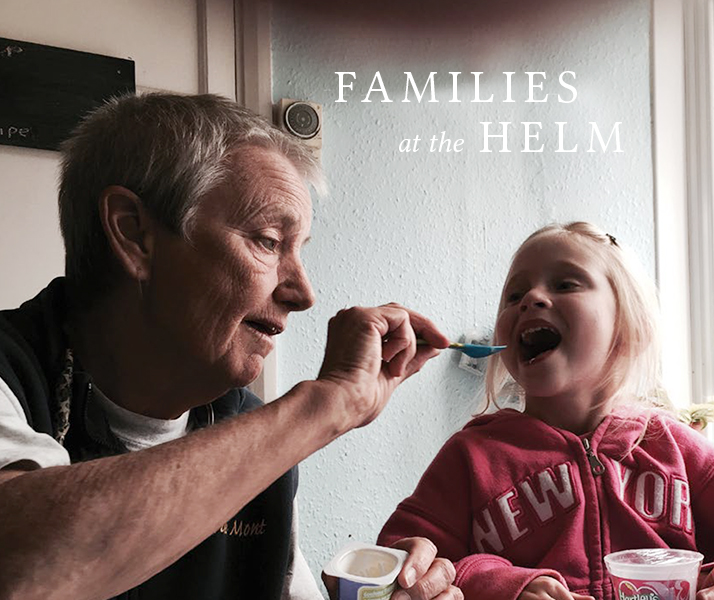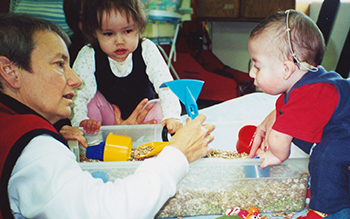
Families at the Helm
At Children’s Therapy Center, Gay Lloyd Pinder ’68 and her two cofounders pioneered techniques of family-centered therapy for children with neuro-developmental issues.
By Martha Park M.F.A. ’15
Gay Lloyd Pinder had never lived away from home when she arrived at Hollins College in 1964. “Basically, I grew up at Hollins,” she says, “I arrived there as a kid, and I left there independent, confident in myself, and with a real excitement about life ahead and the world that was out there.”
She graduated in 1968 with a degree in philosophy, and although she “received a superb education, I wasn’t going to land a job with a degree in philosophy.” So she set out to find what she wanted to do. “I had an eagerness to go and see the world,” she remembers.
Pinder’s father was a minister. A woman in his congregation suggested Pinder reach out to her sister, who’d founded a therapy home in Huemoz, Switzerland, for children with cerebral palsy. “The town was so small we couldn’t find it on a map,” Pinder says, “but my parents, bless their hearts, put me on a plane. I’d never been on a plane, but off I went, and I was there for two years.”
She worked as an aide at Chalet Bellevue in exchange for room and board and $25 a month. By the time she flew back to Virginia, Pinder knew what she wanted to do with the rest of her life. In 1972, she received a master’s degree in speech and language pathology from Boston University.
After graduating, she returned to Virginia to work at Petersburg Training School, a facility with 2,000 residents and two speech therapists. “I always say that was the largest caseload I ever had in my life,” she says.
Over the course of three years at the school, Pinder learned she wanted to work with kids before they became institutionalized. She moved to Maine to work in a home-based program. During this period she took a neuro-developmental treatment course (NDT) focused on working with kids with neuromuscular problems. This course was pivotal in Pinder’s professional development and would be the basis of her later teaching.
From Maine, she moved to Seattle. She didn’t know it yet, but she’d contracted a viral infection and was losing her hearing. “If you have to go deaf,” she says, “Seattle’s a great place to do it.”
As she lost her hearing, Pinder went to a local community college to learn sign language as quickly as she could. She also went through a training program to learn how to use an interpreter. At the same time, she was working at a clinic with physical therapists Nancy Hylton and Sue Hudson. The three therapists shared a dream of opening a small clinic in which services were needed most.

One of three Children’s Therapy Centers; this one is located in Kent, Washington.
“The three of us had enough work experience that we knew what we wanted in a place, and what we didn’t want. We started what we thought would be a tiny private practice.” Within several months, it became clear that Children’s Therapy Center (CTC) would be larger than they’d ever imagined, and would need to be restructured as a nonprofit. “That was in 1979,” Pinder says, “and we’re all still here.”
Since its beginning, CTC has grown to employ 160 people at three sites, with a fourth site on the way. “We were outside the box from the beginning,” Pinder says. “From a managerial perspective, we wanted it to be a place where everybody who worked here owned it—so no hierarchy.”
They also wanted to change therapy culture as a whole, to put families “at the helm,” Pinder says. In this model, ultimately “the therapists see themselves as guests. The chief in the program is the family, and as the child grows up it becomes the child.
“In 1979, the norm was that children would get therapy three to five times per week. One day would be physical therapy, another speech therapy, another occupational therapy. We did not want that model,” Pinder says.

Pinder (center) with Sue Hudson and Nancy Hylton, founders of Children’s Therapy Center.
Instead, all therapists would work together, cotreating the child, with the parents actively involved. Parents would learn how to give physical therapy while changing a diaper, or feeding therapy during snack time. “Our whole goal was to see them once a week, so the rest of the week was theirs,” she says.
In other words, they wanted to treat the whole child. “In the early ’80s,” Pinder says, “that was out of the box. And now, that’s best practice.”
It took about seven or eight years for Pinder to lose her hearing completely. By 1985, she was deaf and had to make a decision. “I’m either going to stay in my field—I’m not sure how I can do that—but I also love what I do. I’m a speech therapist,” she says. “But a deaf speech therapist is an oxymoron. So I said, ‘I’ve always wanted to be a car mechanic.’”
And she set out to do just that, beginning to look into a program to study car mechanics. That’s when the staff of CTC asked if she would consider becoming the director. “Car mechanics would be, I’m sure, very fun,” she says, “but I decided I was going to give this a shot.”
She shifted her professional focus from speech to augmentative communication (AAC) and oral motor/ feeding therapy. Today, she says, “People know me as a feeding therapist. That’s been another fascinating journey.”
Pinder says she is a much better therapist, now that she is deaf. “As a deaf person, my concept of communication is so different than it was when I was hearing. It’s broader, and I’m acutely aware of the power of communication and what happens when people are unable to communicate for whatever reason.”
In 1994, Pinder graduated with a Ph.D. from the University of Washington’s Department of Speech and Hearing Sciences. For the next two decades, she would participate in a collaborative effort between the University of Washington and CTC, studying the development of prelinguistic signals in young children with neuromuscular challenges.
Today, Pinder is gradually cutting back her work. “I realized if I don’t step back, nobody’s going to have the space to step up,” she says. “I have absolutely adored every minute of my career.” The highlight of her work has been “the power of empowering. To empower a family to empower a child, that’s been remarkable to watch. And in my teaching, to empower the therapists I teach.”

Pinder using the feeding therapy techniques she and her colleagues developed.
When Pinder graduated from what was then Hollins College, she couldn’t have imagined all the lives she’d go on to change, the clinic she’d one day found, and the contributions she’d make to the field of neuro-developmental therapy. But when asked about her start at Hollins as a philosophy major, she says, “Hollins is the best thing that ever happened to me, no question. Hollins gave me myself. It prepared me for the world.”
Though she no longer has an active caseload, she still teaches all over the world. Last year, she received the award of excellence from the Neuro-Developmental Treatment Association. She does monthly consultations with younger CTC therapists and the children they work with. And she has a few ideas for her next project. “The Children’s Therapy Center is so strong,” she says, “because of the management style, the concept that the center belongs to everybody. That’s the book I’m going to write.”
Martha Park is a writer and illustrator from Memphis, Tennessee. She received an M.F.A. from Hollins’ Jackson Center for Creative Writing and was the Philip Roth Writer-in-Residence at Bucknell University’s Stadler Center for Poetry.
